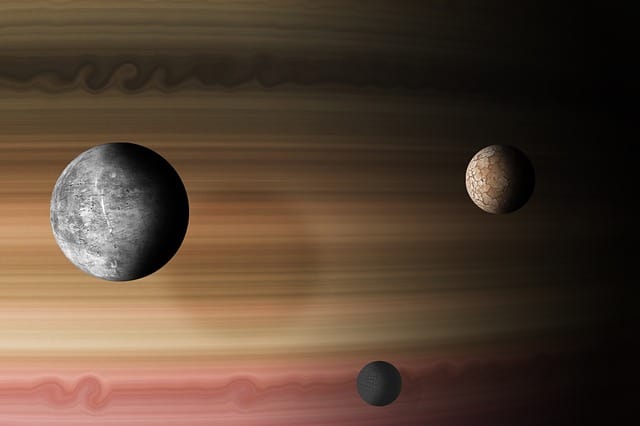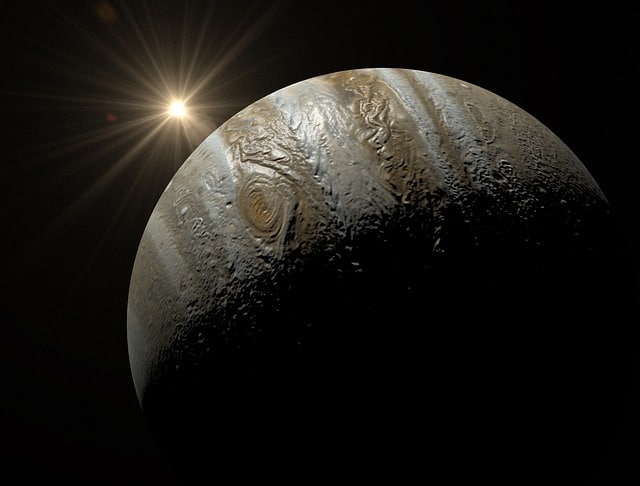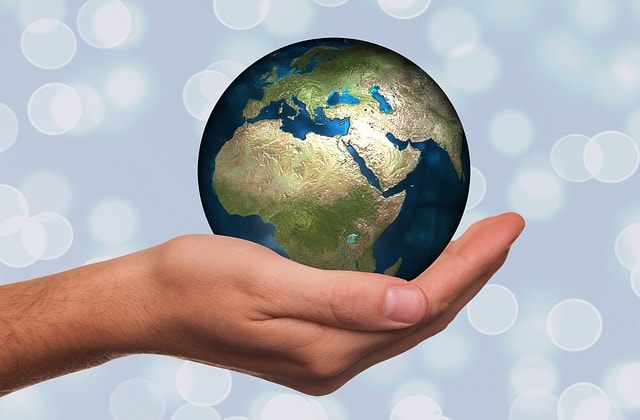What are Gas Giants? (Jupiter, Saturn, Uranus, Neptune)

A gas giant is a gargantuan planet composed mainly of gases that include helium and hydrogen with a comparatively small rocky core. Neptune, Uranus, Saturn and Jupiter are the gas giants of our solar system. These four planets are also called the Jovian Planets after Jupiter because they reside in the outer part of our solar system past the asteroid belt and past Mars. Out of the four Jovian Planets, Jupiter and Saturn are larger than Neptune and Uranus, revealing that the two pairs have different compositions from one another.
The general belief is that these gas giants formed first as icy and rocky planets similar to the terrestrial planets Mercury, Venus, Earth and Mars. However, their respective core sizes allowed them to grab helium and hydrogen out of the gas cloud from the condensing sun and as a result, formed and expelled most of the gas away.
Since Uranus and Neptune are smaller in size compared to Jupiter and Saturn, they, on the other hand, have bigger orbits. Thus, it was more difficult for them to collect helium and hydrogen as efficiently as their brothers Jupiter and Saturn. This explains the reason to why Uranus and Neptune are smaller than their twin counterparts. Also, on a percent basis, their atmospheres contain a greater number of heavier elements such as ammonia and methane since they are indeed smaller.
Over the years, scientists have discovered thousands of other exoplanets. Many of these are similar to our own Jupiter. They are massive gas giants that are very close to their parent stars. This allowed scientist to hypothesize that planets may have moved in a forward and backward motion in their respective orbits before they settled into their current configuration. Despite these evidences, questions still arise regarding on the magnitude of their movement.
Each gas giant encompasses more than a dozen moons. Many of these moons have formed at the same time as their respective parent planets. This fact is indeed true if the planets rotate in the same direction as the planet near its equator. Despite these, one should note that there will always be exceptions.
Let us state Triton as an example. Triton is one of the many moons of Neptune and it orbits the planet in the opposite direction the planet spins which would imply that Triton was captured and did not originate from Neptune. There are many other moons into he solar system that rotate distant from the equator which all implies that they were also captured by the immense gravitational pull of the planet they now belong to.
Each of the gas planets have immense storms and intricate atmospheres. For example, the Great Red Spot on Jupiter has been known for about four-hundred (400) years and is currently shrinking. The reasons for this phenomenon is yet to be discovered. A lot of scientists has provided theories regarding this phenomenon but none of them seem to explain the long-term shrinking effect. According to an astrophysicist at NASA, there is a need for a long term monitoring program of gas giant atmospheres in order to better comprehend the nature behind these complex and great storms.
Jupiter
Jupiter is the largest planet in our solar system with its equator nearly 143,000 kilometers wide. In fact, the size of this planet is so immense that all the other planets in the solar system could fit here. A whopping 1,300 Earths would be able to fit inside Jupiter.
Jupiter is the fifth (5th) planet from the sun that bears a star-like composition. In fact, if Jupiter had been about eighty (80) times more massive, this planet, as we know it, would have become a star. Jupiter has an average distance of 5.2 AU from the sun. It is the second brightest planet at night after Venus and is named after the Roman god King in mythology.
Jupiter’s atmosphere is made up of hydrogen and helium gas. It is covered in thick red, white, brown and yellow clouds. These clouds give Jupiter that stripe-like appearance. Also, one of the planet’s most famous geomorphological features is the Great Red Spot. This, however, is not just a spot. It is a gigantic spinning storm that resembles a hurricane. At its widest, it reaches to about 3.5 times Earth’s diameter. This Great Red Spot is a manifestation of the windy environment of Jupiter. Winds here can react speeds up to more than four-hundred (400) mph.
Saturn
Because of its rings, Saturn is the most beautiful planet in our solar system; it is also the second (2nd) largest planet. Jupiter is not the only planet that have rings made up of chucks of rock and ice but in this case, none of the other rings of the Gas Giants are as spectacular or as intricate as Saturn’s. And like its other fellow Gas Giants, it is also a massive planet composed of helium and hydrogen.
The planet is surrounded by fifty-three (53) confirmed and nine (9) provisional moons. It is also home to the most fascinating landscapes in our solar system. From the methane lakes on smoggy Titan to the jets of Enceladus, Saturn indeed holds many mysteries and is a rich source of scientific discovery.
Saturn is the second farthest planet from Earth observable by the naked human eye. The existence of Saturn been known since the ancient times hence, it was named after the Roman god of wealth and agriculture. This planet rotates in the same direction as Earth from west to east but does it faster. It takes only 10.7 hours to complete a day. However, the speed of its spin has caused its equatorial radius to bulge about 10% wider than the planet’s polar radius.
Uranus
Uranus is the seventh (7th) planet from the sun. It also has the third (3rd) largest diameter in the solar system. This col and winy plant is an ice giant which is surrounded by thirteen (13) faint rings and twenty-seven (27) small moons as it rotates perpendicularly with respect to the other planets.
This planet was first discovered by a telescope in 1781 by William Herschel, an astronomer. Uranus has an equatorial diameter of 51,118 km. Uranus is named after an ancient Greek God of the Heavens. The son of Gaia and the father of Cronus. Uranus has a polar diameter of 49,946 km. Uranus is the first planet discovered in the modern times. The planet was discovered by a British astronomer, Sir William Herschel who, while searching the sky using his telescope on March 13, 1781, noticed the planet and named it Georgium Sidus or the Georgian Planet. Voyager 2 visited Uranus on January 24, 1986. The mass of Uranus is 8.68×10^25 kg which is about fifteen (15) earths.
Uranus is an ice giant and does not have a true surface. In fact, it is composed of mainly swirling fluids. A spacecraft would have no place to land on the planet, moreover, it won’t be able to fly through its atmosphere either since its extreme pressures and temperatures would instantly obliterate any metal spacecraft.
Neptune
This is the first planet to be located using mathematical predictions rather than mere observations from the sky. This was done by a French Mathematician named Urbain Joseph Le Verrier who proposed that the location and mass of another planet is the direct effect of the orbit changes of the planet Uranus.
Neptune’s magnetic field is tipped over by nearly forty-seven (47) degrees compared with Neptune’s rotation axis. Similar to Uranus, the planet’s magnetosphere constantly undergoes variations during each rotation due to this misalignment. Neptune’s magnetic field is about twenty-seven (27) times more powerful than Earth’s.





